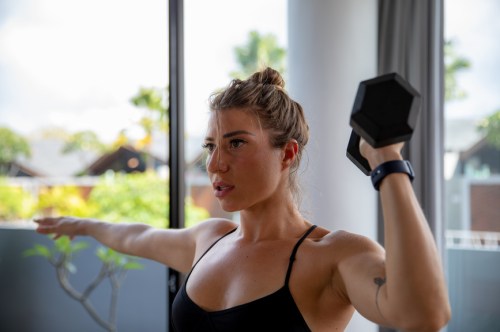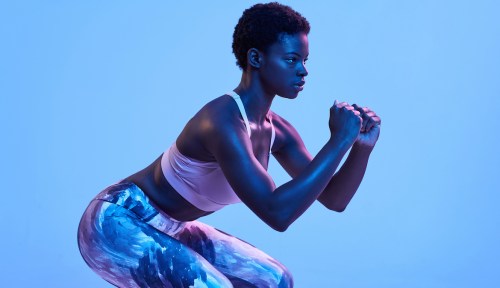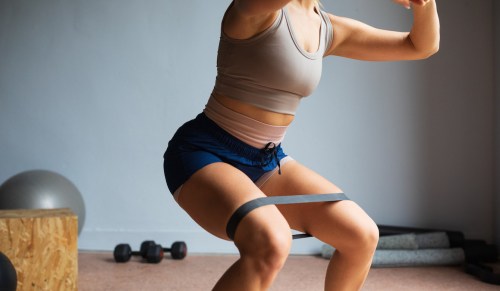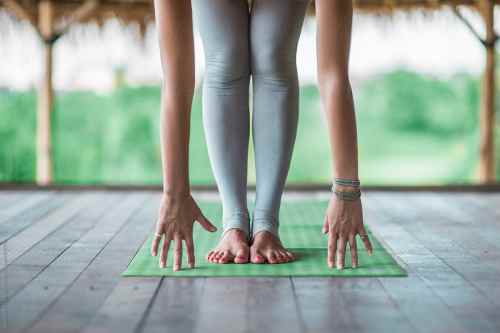“Am I even doing this right?” is probably a question that’s crossed your mind in strength training workouts. Not only are there many tiny cues that help you execute your rows, bicep curls, and deadlifts, but there’s also jargon galore (reps! sets! supersets!) to learn along the way. If you’re training your full body, you may start to notice that certain muscles are, well, swoll-er than others. For example, maybe your triceps have nothing on your glutes. If you’re wondering why your lower body is stronger than your upper body, lead FitOn app trainer, Caroline Pearce, MSc, says there’s a perfectly reasonable explanation.
Experts in This Article
Caroline Pearce is a former International heptathlete and bobsledder for Great Britain and successful TV Presenter, reporter, commentator and event host. She is a published author and go-to fitness and nutrition consultant and influencer with a First Class Honours Degree in Sports Science and Master’s Degree in Nutrition and Exercise Physiology from Loughborough University.
“The most obvious difference [between the upper and lower body] is the size of the muscles, with the lower body accommodating the largest muscles in the body, the gluteal muscles in particular,” says Pearce. “Typically, we use our lower body more throughout the day as we walk around, go up the stairs, and complete daily tasks such as sitting and standing—aka squatting—frequently. Our upper body takes less load unless we’re specifically lifting objects—which we do less often.” Makes total sense, right? If you walked around on your hands all day, those upper-body muscles would likely become the stronger ones—but since evolution has not (yet) led us all to handstand our way through life, those glutes, quads, thighs, and calves are the strongest.
If you’re into strength training, you’ve probably noticed that this strength imbalance means you can lift way heavier with your lower body than you can with your upper body. “It’s very normal to be able to lift more weight with your lower body compared to what you can lift with your upper body, unless you’ve specifically lifted heavy upper body weights for an extended period of time and neglected your lower body,” explains Pearce. Generally speaking, she says you can expect to lift double the weight with your lower body compared to your upper body. Meaning, you might be rocking 15-pound dumbbells for bicep curls, but 30 pounds or more for your sumo squats.
Now that you’ve level set your expectation for your upper and lower body, you’re ready to train both regions to be the strongest, most mobile they can be. “There are several ways to apply progressive overload to the muscles so they strengthen and build,” says Pearce. Below, she breaks down the basic steps for training your full body while honoring the key differences between your various muscle groups.
1. Establish a base level of strength for your upper and lower body
“First, achieve a base level of strength where you lift higher reps—15 to 20 reps for three rounds—with a lighter load to get familiar with the movement patterns and range of motion,” says Pearce. Obviously, this base level will be different for the muscles of your lower and upper body.
2. Apply progression
You can progress in two ways, says Pearce. First, you can opt for higher reps (eight to 12) and more sets (three to five) to improve your strength, with two to three minutes rest in between. Second, you can vary your exercises so that your muscles have to adapt. “The equipment used can vary the stimulus also, switching from dumbbells to cables to barbells,” explains Pearce.
3. Superset
“Super-setting the exercise in question with an antagonistic muscle movement—triceps kickback superset with biceps curl for example—can further allow you to challenge the muscles to respond and get stronger,” says Pearce. “This, in turn, means you will gradually be able to lift more weight.
4. Be consistent
Make sure you’re giving your upper and lower body equal measures of love. “If you’re doing a total body workout, complete exercises for arms and legs or do exercises that combine both in one such as a burpee or squat to overhead press. If you like to train different body parts on different days, ensure for every ‘leg day’ you have an ‘arm day’ and so forth,” says Pearce.
Try this full-body workout at home:
Oh hi! You look like someone who loves free workouts, discounts for cutting-edge wellness brands, and exclusive Well+Good content. Sign up for Well+, our online community of wellness insiders, and unlock your rewards instantly.
Sign Up for Our Daily Newsletter
Get all the latest in wellness, trends, food, fitness, beauty, and more delivered right to your inbox.
Got it, you've been added to our email list.











